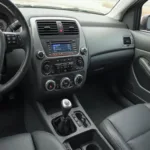Ancel OBD2 throttle adaptation is a process of resetting the throttle position sensor on a vehicle using an Ancel OBD2 scanner. This process is often necessary after cleaning the throttle body or replacing related components. By performing an Ancel OBD2 throttle adaptation, you can ensure that your vehicle’s engine is receiving the correct amount of air, resulting in smoother idling, improved acceleration, and overall better performance.
Understanding Throttle Adaptation
Before diving into the specifics of Ancel OBD2 throttle adaptation, it’s crucial to grasp the basic concept of throttle adaptation itself. In essence, throttle adaptation refers to the engine control unit’s (ECU) ability to learn and adjust to the mechanical wear and tear that naturally occurs within the throttle body over time.
The throttle body, responsible for controlling the amount of air entering the engine, relies on a sensor to relay its position to the ECU. However, factors like carbon buildup, debris, and mechanical wear can impact the sensor’s accuracy, leading to inaccurate readings being sent to the ECU. This, in turn, can cause a range of performance issues, including rough idling, hesitant acceleration, and even the dreaded “Check Engine” light.
Throttle adaptation comes into play as a corrective measure. By performing an adaptation procedure, you essentially “reintroduce” the ECU to the throttle body’s current state. The ECU then uses this fresh data to remap the throttle position sensor’s signal, ensuring that it aligns with the actual throttle plate position. This remapping process effectively compensates for any mechanical discrepancies, restoring harmony between the throttle body and the ECU.
When is Ancel OBD2 Throttle Adaptation Necessary?
Ancel OBD2 throttle adaptation is typically required in the following scenarios:
- After Cleaning the Throttle Body: Accumulated dirt and grime can disrupt the throttle plate’s movement and affect sensor readings.
- After Replacing the Throttle Body: A new throttle body requires calibration to ensure proper communication with the ECU.
- After Replacing the Throttle Position Sensor: A new sensor needs to be synchronized with the throttle body and ECU.
- Experiencing Symptoms of Throttle Body Issues: If you notice rough idling, poor acceleration, or other throttle-related problems, adaptation may be necessary.
How to Perform an Ancel OBD2 Throttle Adaptation
Performing an Ancel OBD2 throttle adaptation is a relatively straightforward process, but it’s essential to follow the correct steps:
- Consult Your Vehicle’s Repair Manual: Before attempting any procedure, always refer to your vehicle’s specific repair manual for detailed instructions and precautions.
- Gather the Necessary Tools: You will need an Ancel OBD2 scanner compatible with your vehicle model.
- Park Your Vehicle: Ensure your vehicle is parked on a level surface, the engine is off, and the parking brake is engaged.
- Connect the Ancel OBD2 Scanner: Locate your vehicle’s OBD2 port (usually under the dashboard on the driver’s side) and connect the Ancel scanner.
- Turn On the Ignition: Turn the ignition key to the “On” position but do not start the engine.
- Access the Throttle Adaptation Function: Using the Ancel scanner’s navigation menu, navigate to the “Throttle Adaptation” or “TPS Reset” function. The exact wording may vary depending on the scanner model.
- Follow the On-Screen Prompts: The scanner will guide you through a series of steps, which may include turning the ignition off and on, pressing the accelerator pedal, or other specific actions.
- Complete the Adaptation Process: Once the scanner indicates that the adaptation is complete, you can disconnect the device and start your vehicle.
Choosing the Right Ancel OBD2 Scanner for Throttle Adaptation
Ancel offers a wide range of OBD2 scanners, but not all models support throttle adaptation for all vehicle makes and models. When selecting an Ancel scanner for throttle adaptation, consider the following factors:
- Vehicle Compatibility: Ensure the scanner explicitly states its compatibility with your vehicle’s make, model, and year.
- Throttle Adaptation Capability: Verify that the scanner offers the specific function of throttle adaptation or TPS reset.
- Software Updates: Choose a scanner that allows for software updates to ensure compatibility with the latest vehicle models and technologies.
Benefits of Proper Throttle Adaptation
Proper throttle adaptation offers several benefits, including:
- Smoother Idling: A well-adapted throttle body ensures a consistent and stable idle speed, preventing rough or erratic idling.
- Improved Acceleration: Accurate throttle position readings translate to crisper and more responsive acceleration.
- Reduced Emissions: Optimal air-fuel mixture achieved through proper adaptation contributes to lower emissions.
- Enhanced Fuel Efficiency: Improved engine performance and reduced emissions often lead to better fuel economy.
Troubleshooting Throttle Adaptation Issues
While Ancel OBD2 throttle adaptation is generally a straightforward process, you might encounter some issues. Here are some troubleshooting tips:
- Verify Scanner Compatibility: Double-check that your Ancel scanner is indeed compatible with your vehicle model and supports throttle adaptation.
- Check for Error Codes: If the adaptation process fails, use the scanner to check for any error codes that might indicate underlying issues.
- Inspect for Vacuum Leaks: Vacuum leaks can disrupt throttle body operation and prevent successful adaptation.
- Consult a Professional Mechanic: If you’re unable to perform the adaptation or resolve any issues, it’s best to consult a qualified mechanic for assistance.
Conclusion
Ancel OBD2 throttle adaptation is a valuable procedure that can significantly improve your vehicle’s performance and drivability. By understanding the process and using the right Ancel OBD2 scanner, you can ensure that your throttle body and ECU work in perfect harmony.
If you have any further questions or need assistance, feel free to contact our expert team via WhatsApp: +1(641)206-8880 or Email: [email protected]. We’re available 24/7 to help you with all your automotive diagnostic needs.

